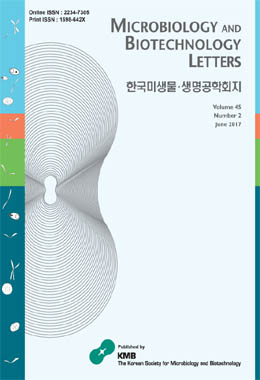4-Hydroxybenzyl alcohol (4-HB alcohol)은 두통, 경련 행동, 현기증과 같은 신경계 질환에 유익한 효과를 나타내며 천마의 주요 생리활성 성분 중의 하나이다. 대사공학을 통해 4-hydroxybenzoate (4-HBA)를 생산하는 균주로부터 4-HB alcohol을 생산하는 재조합 Corynebacterium glutamicum을 개발하였다. 먼저 4-HBA를 생산하는 APS809로부터 염색체 내 NCgl2922 유전자에 Methanocaldococcus jannaschii 유래의 aroK 유전자를 삽입한 APS963을 개발하였다. 4-HBA의 카로복실 산을 4-hydroxybenzaldehyde (4-HB aldehyde)로의 환원을 촉매하는 Nocardia iowensis 유래의 car 유전자를 염색체에서 발현하는 균주를 개발하기 위해 NCgl1112 유전자 일부 단편에 car 유전자가 삽입된 GAS177를 개발하였다. 더 높은 농도의 4-HB alcohol을 생산하기 위해 4-HB alcohol을 aldehyde로 산화를 촉매하는데 관여하는 creG 유전자를 염색체상에서 제거된 GAS255를 개발하였다. 최종적으로 chorismate를 4-HBA로 전환하는 효소의 유전자 ubiCpr을 pcaHG에 삽입된 GAS355를 개발하였으며, 80 g/l 포도당을 함유한 삼각플라스크에서 발효하여 생산성을 평가한 결과, 2.3 g/l 4-HB alcohol이 생산되었으며 부산물로 0.32 g/l 4-HBA, 0.3 g/l 4-HB aldehyde가 축적되었다.
4-Hydroxybenzyl alcohol (4-HB alcohol) is one of the major active components of Gastrodia elata Blume, with beneficial effects on neurological disorders such as headache, convulsive behavior, and dizziness. Here, we developed a metabolically engineered Corynebacterium glutamicum strain able to produce 4-HB alcohol from 4-hydroxybenzoate (4-HBA). First, the strain APS963 was obtained from the APS809 strain via the insertion of aroK from Methanocaldococcus jannaschii into the NCgl2922-deleted locus. As carboxylic acid reductase from Nocardia iowensis catalyzes the reduction of 4HBA to 4-hydroxybenzaldehyde (4-HB aldehyde), we then introduced a codon-optimized car gene into the genome of APS963, generating the GAS177 strain. Then, we deleted creG coding for a putative short-chain dehydrogenase and inserted ubiCpr encoding a product-resistant chorismate-pyruvate lyase into the pcaHG-deleted locus. The resulting engineered GAS355 strain accumulated 2.3 g/l 4-HB alcohol with 0.32 g/l 4-HBA and 0.3 g/l 4-HB aldehyde as byproducts from 8% glucose after 48 h of culture.




